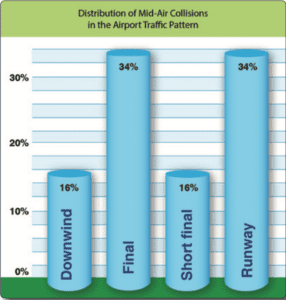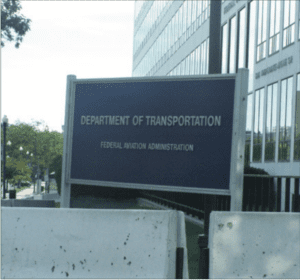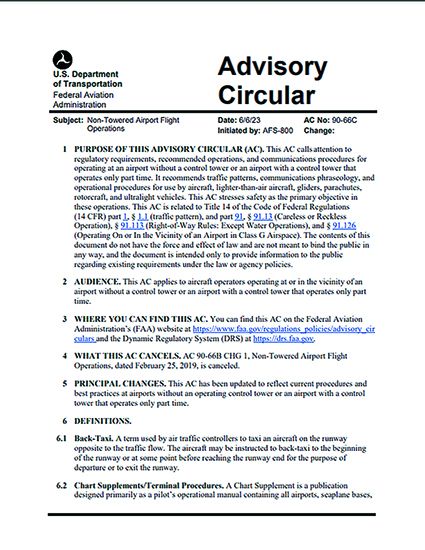An FAA Advisory Circular released June 6, 2023, rewrites the agency’s previous guidance on the rules and procedures we should use when flying at non-towered (uncontrolled) airports. Advisory Circular AC 90-66C, “Non-Towered Airport Flight Operations,” updates previous guidance “to reflect current procedures and best practices at airports without an operating control tower or an airport with a control tower that operates only part time.”
The new AC cancels the previous version, which was published in 2019, and—except for a pandemic—not that much has changed. So, why should you download it from the FAA’s website (tinyurl.com/safnotwr)? Because while the newly revised version may not have earth-shaking changes inside, it is the latest guidance on a perennial topic in pilot lounges everywhere. And there are some information nuggets in the FAA’s guidance. If you haven’t reviewed non-towered airport operations in a while, the AC is a good refresher.
Some Reminders

It’s no secret that traffic patterns and how to enter them, plus the radio communication skills necessary to enhance safety can be controversial, especially in the pilot lounge and, occasionally, in these pages. The AC attempts to set us straight on many of those topics.
For example, per the Aeronautical Information Manual (AIM), the AC states in specific terms that using the phrase, “Any traffic in the area, please advise,” is not “a recognized self-announce position and/or intention phrase and should not be used under any condition.” The expectation is that any other radio-equipped traffic will a) be on the correct frequency and, b) respond to your self-announced position/intention: “Any traffic that is present at the time of your self-announcement that is capable of radio communications should reply without being prompted to do so.”
Another reminder involves what exactly the FAA rules are at non-towered airports and what they don’t have rules for. Traffic pattern entries are something that’s not regulated, for example: the agency only regulates traffic pattern flow, not the entry. So straight-in approaches, while certainly legal, are not recommended “when there are other aircraft in the traffic pattern. The straight-in approach may cause a conflict with aircraft in the traffic pattern and on base to final and increase the risk of a midair collision.”
And how about those pattern entries? “Arriving aircraft should be at traffic pattern altitude and allow for sufficient time to view the entire traffic pattern before entering. Entries into traffic patterns while descending may create collision hazards and should be avoided. Entry to the downwind leg should be at a 45-degree angle abeam the midpoint of the runway to be used for landing. Aircraft should always enter the pattern at pattern altitude, especially when flying over midfield and entering the downwind directly.”
FAA Reauthorization And Pilot Experience

Every few years, Congress has to develop and pass legislation regarding the FAA. The so-called reauthorization bills set funding limits and direct the agency to meet various priorities or implement new policies. The most recent major FAA bill was in 2018, and it expires September 30, 2023, so here we are.
While each reauthorization goes through a different process, they largely are not controversial, at least in the way that federal budgets and debt-ceiling increases have become in recent years. There usually is a sticking point, though, a controversy to which one politician or another stakes a claim. This cycle, the sticking point is the apparent pilot shortage and the minimum requirements for one to serve as second-in-command (SIC) of an airplane operated under FAR Part 121.
Minimum Pilot Experience
It used to be that a commercial pilot certificate was a minimum requirement for serving as SIC aboard a FAR Part 121 operation. That became an airline transport pilot (ATP) certificate in the aftermath of the Colgan Air Flight 3407 tragedy outside Buffalo, N.Y., on February 12, 2009, in which all 49 passengers and crew were killed, plus one person on the ground. Since the Colgan 3407 crash and instatement of the 1500-hour rule, there has not been a multiple-fatality accident involving a major U.S.-based airline. Knock wood.
But many point to the 1500-hour minimum and blame it for an ongoing shortage of qualified pilots. The Regional Airline Association (RAA), which represents smaller carriers, is particularly concerned since its pilots are recruiting targets of the major airlines once they reach 1500 hours total time.
According to RAA, “The impacts of the pilot shortage are real. Currently, more than 500 regional aircraft are parked, and those aircraft remaining in service are underutilized.”
“There has never been a worse time to consider weakening pilot certification requirements to produce less experienced pilots,” said U.S. Sen. Tammy Duckworth (D-Ill.), a U.S. Army veteran helicopter pilot who chairs a subcommittee in charge of the bill. She was referring to a proposal by Sen. Kyrsten Sinema (I-Ariz.) to expand the credit toward 1500 hours allowed by certain airline training programs. The disagreement is delaying Senate action on a new FAA bill.




